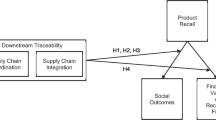Abstract
After a number of food safety crises, the design and implementation of traceability systems became an important tool for managing safety risks in the food industry. In the literature, numerous studies deal with traceability from the viewpoint of information system and technology development. However, traceability and its implications for food safety receive less attention in literature on production and distribution planning. From the viewpoint of operations management, an efficient management of food safety risks requires the consideration of the amounts of potentially recalled products, affected regions/customers, and logistics efforts connected to solving the safety problem. In this paper we are developing a production and distribution planning model for food supply chains to address these issues. We also present heuristics for solving the resulting mixed-integer linear programming model and demonstrate the effectiveness of the developed methodology in a numerical investigation.
Similar content being viewed by others
References
Asensio L, Gonzalez I, Garcia T, Martin R (2008) Determination of food authenticity by enzyme-linked immunosorbent assay. Food Control 19: 1–8
Axsater S (1980) Economic lot sizes and vehicle scheduling. Eur J Oper Res 4: 395–398
Axsater S (1982) Worst case performance for lot sizing heuristics. Eur J Oper Res 9: 339–343
Bello LL, Mirabella O, Torrisi N (2005) A general approach to model traceability systems in the food chains. In: 10th IEEE conference on emerging technologies and factory automation, September 22, 2005, pp 207–214
Beulens AJM, Broens DF, Folstar P, Hofstede GJ (2005) Food safety and transparency in food chains and networks: relationships and challenges. Food Control 16: 481–486
Bitran GR, Magnanti TL, Yanasse HH (1984) Approximation methods for the uncapacitated dynamic lot size problem. Manag Sci 30: 1121–1140
Brul S, van Gerwen S, Zwietering M (2007) Modelling microorganisms in food. Woodhead Publishing, Cambridge
Cimino MGCA, Lazzerini B, Marcelloni R, Tomasi A (2005) Cerere: an information system supporting traceability in the food chain. In: 7th IEEE international conference on E-commerce, technology, July 19, 2005, pp 90–98
Dupuy C, Botta-Genoulaz V, Guinet A (2005) Batch dispersion model to optimize traceability in food industry. J Food Eng 70: 333–339
European Parliament and Council (2002) General principles and requirements of food law. Regulation (EC) No 178/2002. Official Journal of the European Communities, vol. 1.2.2002. L31/1–L31/24
Fransoo JC, Rutten WGMM (1994) A typology of production control situations in process industries. Int J Oper Prod Manag 14: 47–57
Gaucker L, Seifert W (2007) Applications of RFID in supply chains. In: Jung H, Chen FF, Jeong B (eds) Trends in supply chain design and management: technologies and methodologies. Springer, New York
Hillson D, Murray-Webster R (2007) Understanding and managing risk attitude, 2nd edn. Gower, Aldershot
Jansen-Vullers MH, van Dorp CA, Beulens AJM (2003) Managing traceability information in manufacture. Int J Inf Manag 23: 395–413
Kelepouris T, Pramatari K, Doukidis G (2007) RFID-enabled traceability in the food supply chain. Ind Manag Data Syst 107: 183–200
Koutsoumanis K, Taoukis PS, Nychas GJE (2005) Development of a safety monitoring and assurance system for chilled food products. Int J Food Microbiol 100: 253–260
Labuza TP (1982) Shelf-life dating of foods. Food & Nutrition Press, Westport
Moe T (1998) Perspectives on traceability in food manufacture. Trends Food Sci Technol 9: 211–214
Opara LU (2003) Traceability in agriculture and food supply chain: a review of basic concepts, technological implications, and future prospects. Int J Food Agric Environ 1: 101–106
Rong A, Akkerman R, Grunow M (2009) Mixed-integer linear programming approach for food production and distribution planning. Int J Prod Econ. doi:10.1016/j.ijpe.2009.11.026
Schwägele F (2005) Traceability from a European perspective. Meat Sci 71: 164–173
Silver EA, Meal HC (1973) A heuristic for selecting lot size quantities for the case of a deterministic time-varying demand rate and discrete opportunities for replenishment. Prod Invent Manag 14: 64–74
Spitter JM, Hurkens CAJ, de Kok AG, Lenstra JK, Negenman EG (2005) Linear programming models with planned lead times for supply chain operations planning. Eur J Oper Res 163: 706–720
Terreri A (2009) Preventing the next product recall. Food Logist 111: 20–25
Trienekens JH, Beulens AJM (2001) The implications of EU food safety legislation and customer demands on supply chain information systems. In: Proceedings of the 11th annual World Food and Agribusiness Forum. International Food and Agribusiness Mangement Association, Sydney, Australia
Vachani R (1992) Performance of heuristics for the uncapacitated lot-size problem. Naval Res Logist 39: 801–813
van der Vorst GAJ (2004) Performance levels in food traceability and impact on chain design: results of an international benchmark study. In: Bremmers H (ed) Proceedings of 6th international conference on chain and network management in agribusiness and the food industry, pp 175–183
van der Vorst GAJ, Tromp SO, van der Zee DJ (2009) Simulation modelling for food supply chain redesign: integrated decision making on product quality, sustainability and logistics. Int J Prod Res 47: 6611–6631
van Dorp KJ (2002) Tracking and tracing: a structure for development and contemporary practice. Logist Inf Manag 15: 24–33
Wagner HM, Whitin TM (1958) Dynamic version of the economic lot size model. Manag Sci 5: 89–96
Wang X, Li D (2006) Value added food traceability: a supply chain management approach. In: IEEE international conference on service operations and logistics and informatics, pp 493–498
Wang X, Li D, O’Brian C (2009) Optimisation of traceability and operations planning: an integrated model for perishable food production. Int J Prod Res 47(11): 2865–2886
Wang X, Li D, O’Brian C, Li Y (2010) A production planning model to reduce risk and improve operations management. Int J Prod Econ 124: 463–474
Wilson TP, Clarke WR (1998) Food safety and traceability in the agricultural supply chain: using internet to deliver traceability. Supply Chain Manag Int J 3: 127–133
Author information
Authors and Affiliations
Corresponding author
Rights and permissions
About this article
Cite this article
Rong, A., Grunow, M. A methodology for controlling dispersion in food production and distribution. OR Spectrum 32, 957–978 (2010). https://doi.org/10.1007/s00291-010-0210-7
Published:
Issue Date:
DOI: https://doi.org/10.1007/s00291-010-0210-7




